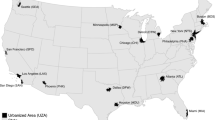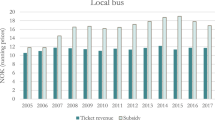Abstract
This paper examines the impact of policy changes in the funding of New Zealand public transit modes.
These changes, introduced in 1983, are evaluated in terms of the net incidence of public transit subsidy assistance, taking into account its source of funding and the income class of those commuters benefiting from the subsidy. The general conclusion is that the net incidence of subsidy assistance remains progressive (i.e., a transfer from high to low income commuters) following the introduction of shared funding on the predominant public transit modes (rail and bus), sourced from income tax (central government) and property tax (regional/local government). However, because of the predominance of medium to high income commuters on rail vis-a-vis bus and the traditional source of funding on these modes in terms of income tax (a progressive tax source) and property tax (a regressive tax source), the degree of progressivity previously associated with public transit subsidies has now substantially reduced.
Similar content being viewed by others
References
Amos, P. & Starrs, M., 1984. “Public Transport Subsidies in Adelaide”. 9th Australian Transport Research Forum. Proceedings Papers, pp. 595–611.
Cervero, R., 1984. “Cost and performance effects of transit operating subsidies in the United States”. International Journal of Transport Economics, Vol. X (3): 379–394.
Frankena, M.W., 1973. “Income distributional effects of urban transit subsidies”. Journal of Transport Economics and Policy, Vol. 7 (3): 215–230.
Grey, A., 1975. Urban Fares Policy. Saxon House.
Guria, J.C. & Gollin, A.E.A., 1985. “Influence of income and public transit accessibility on the modal choice behaviour of the New Zealand labour force”. International Journal of Transport Economics, Vol. XIII (3): 301–313.
Gwilliam, K. M., 1984. “Aims and effects of public financial support for passenger transport”. ECMT Round Table; No. 67, pp. 9–61.
Larner, T.C., 1984. “The distribution effect of bus subsidies in West Yorkshire”. Traffic Engineering and Control, 25(a): 429–433.
Pucher, J., 1981. “Equity in transit finance”. Journal of the American Planning Association, No. 47: 387–407.
Pucher, J., 1983. “Who benefits from transit subsidies?: Recent evidence from six metropolitan areas”. Transportation Research, Vol. 1, 17A (1): 39–50.
Author information
Authors and Affiliations
Additional information
The analysis and opinions expressed in this paper are the responsibility of the author alone and do not purport to represent the views of the Ministry of Transport.
Rights and permissions
About this article
Cite this article
Guriai, J.C., Gollinz, A.E.A. Net tax incidence for urban public transit subsidies in New Zealand. Transportation 13, 319–328 (1986). https://doi.org/10.1007/BF00215252
Issue Date:
DOI: https://doi.org/10.1007/BF00215252




